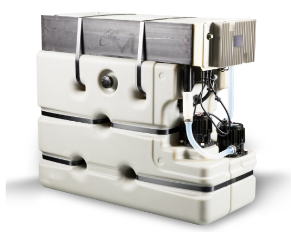Redflow Company Overview
Flow Batteries Explained
A flow battery is a unique type of rechargeable battery, where energy is stored in two liquid chemical solutions. These solutions are kept separate by a membrane within the battery’s cell. The magic happens when these liquids circulate in their own compartments and interact through the membrane, allowing ions to exchange and create electricity. This process can be harnessed to both store and release energy.

What sets flow batteries apart from traditional batteries is their method of storing energy. Instead of using solids, flow batteries utilize liquids. This means you can easily increase a flow battery’s storage capacity (recharge the battery) simply by adding more liquid to its tanks.
A critical aspect of flow batteries is that their energy capacity is determined by the amount of liquid electrolyte they hold, whereas their power output is influenced by the surface area of the electrodes within them. This relationship between liquid volume and electrode surface area typically means that flow batteries are larger and heavier compared to other battery types.
Redflow Battery Technologies
Redflow currently offer the ZBM3 (generation 3) zinc-bromine flow battery. This is the successor to previous popular batteries like the Redflow Z-Cell.
ZBM3 series

The Redflow ZBM3 has the crown as the world’s smallest commercially available zinc-bromine flow battery which is a testament to Redflow’s pioneering role in the flow battery market.
The ZBM3 provides a maximum of 10kWh of output in each cycle with a continuous power rating of 3kW (5kW Peak). That is sufficient to run 80% of typical household appliances while bigger draws from EV Charger, large AC units and pool pumps may require 2 ZBM3’s to operate without topping up power from the grid.
The battery is very heavy weighing 240kg or 90kg without the 100 litres of internal electrolyte. The battery dimensions are 40cm wide by 86cm long and 75cm high.
The battery is resilient to temperature change with a normal operating temperature between 10 degrees and 40 degrees with no air conditioning required.
These batteries are manufactured in Redflow’s Thailand facility and come with a standard 1 year warranty that can be extended to 10 years with an additional cost.
How much do Redflow ZBM3 batteries cost?
Redflow’s ZBM3 batteries cost around $11,000 to $12,000 excluding installation. This makes them slighly dearer than lithium batteries of a similar capacity rating, however flow batteries have various advantages over different battery technologies.
Redflow’s Warranty Policy for Australian Customers
Redflow’s warranty document does not appear on their website so we have been unable to examine the terms for this review.
Their datasheet for the ZBM3 battery outlines a 1 year standard warranty which covers an energy through-put of 3,650 kWh (or 10kWh per day).
They outline that this can be extended to a 10 year or 36,500 kWh warranty with an option long term service agreement. The details of this long term service agreement are not available on Redflow’s website.
Pros and Cons of Redflow Batteries
Pros:
- World leader in flow battery technology
- Main affordable flow battery at residential scale
- Very safe technology with low fire risk
- Low degredation which provides a very low long-term cost of energy
Cons:
- Battery is larger and heavier than lithium batteries and is less aesthetically appealling
- Low power rating of 3kW for 10kWh which limits performance
- Higher upfront cost when compared to lithium batteries
- Flow batteries are still considered an emerging technology and don’t have the same track record as lithium batteries
Battery government rebate schemes across Australia
Currently there is no federal rebate for battery storage. Victoria, South Australia and the ACT have launched their own schemes that are now closed.
The main battery scheme currently available is Queensland’s Home Battery Booster rebate.
Read more product reviews from Solar Choice
- Solar Panel Costs: Solar Choice Price Index | April 2025 - 1 April, 2025
- Solar Panels For Homes – All You Need to Know About Solar Systems - 18 March, 2025
- Best NSW Solar Feed-In Tariffs - 17 March, 2025
